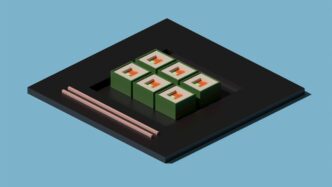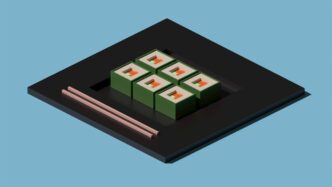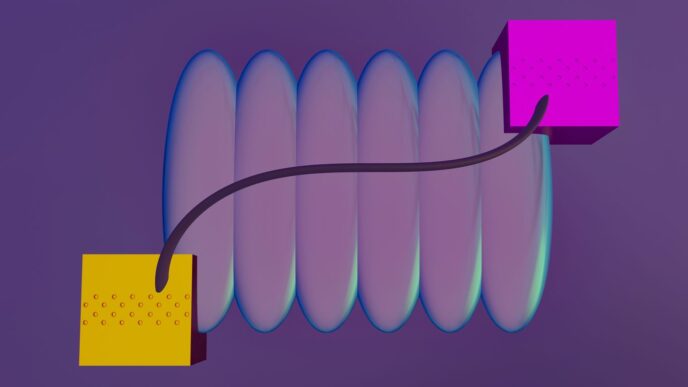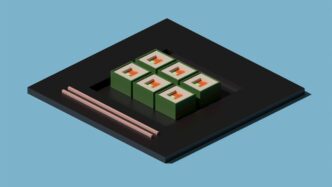So, you’re curious about the IBM quantum computer, huh? It’s a pretty wild area, and IBM is really pushing the envelope. They’ve been at this for a while, building up their quantum systems from smaller chips to ones with over a thousand qubits. It’s not just about making more qubits, though; they’re also focused on making them work better and reducing errors. This whole field is moving fast, and IBM is right there, working on everything from the hardware itself to the software you’d use to program it. They’re even teaming up with other companies to figure out how this technology can actually be used for real problems. It’s a complex topic, but basically, IBM is building powerful quantum computers and trying to make them useful.
Key Takeaways
- IBM has been steadily increasing the number of qubits in its quantum processors, moving from early models to large-scale chips like Condor with over 1,000 qubits.
- Alongside qubit count, IBM is prioritizing improved error resistance, as seen with the Heron processor, which has a significantly lower error rate than previous models.
- IBM is exploring a future of ‘quantum utility,’ where quantum computers can perform tasks beyond the reach of classical simulations, even before achieving full fault tolerance.
- The company provides software tools like Qiskit to help developers create and run quantum programs, aiming to make quantum computing more accessible.
- IBM is actively forming partnerships across various industries to find practical applications for quantum computing and drive innovation in the field.
Advancing The IBM Quantum Computer
Overview Of IBM Quantum’s Initiative
IBM Quantum isn’t just building quantum computers; they’re charting a course for a whole new era of computing. Think of it as moving beyond just having a powerful engine to designing a whole new kind of vehicle. They’ve been pushing hard to get quantum computers to do things that even the biggest classical supercomputers can’t handle. A big moment was in 2023 when experiments showed quantum computers could run circuits that were just too complex for classical machines to simulate, even with all their brute force. This is a huge step because it means we’re starting to see practical uses for quantum computing, not just theoretical ones. IBM Quantum is focused on making these machines useful, not just powerful.
Evolution Of IBM Quantum Hardware
It’s been quite a journey watching IBM’s quantum hardware grow. They started with processors like Eagle, and then came Condor, which packed over 1,100 qubits. That was a big jump in sheer numbers. But it’s not just about more qubits; it’s about better ones. The Heron processor, for instance, is a big deal because it significantly improves performance over Eagle and, importantly, it’s much better at reducing errors and crosstalk between qubits. This focus on quality and error reduction is key. They’re building these processors using advanced techniques, like improved fabrication and a lot of intricate wiring, all packed into specialized cooling systems.
Here’s a look at some key processors:
- Eagle: A previous flagship processor, serving as a benchmark for improvements.
- Condor: Notable for its high qubit count (1,121 qubits), pushing the boundaries of scale.
- Heron: Introduces enhanced performance and significantly reduced error rates, forming the basis for future roadmaps.
Performance Metrics For IBM Quantum Systems
When we talk about how well these quantum computers are doing, it’s not just about counting qubits. IBM looks at a few things to measure progress. One important metric is the number of gates a processor can handle in a circuit, and how complex those circuits can get. For example, they’ve reached a point where they can run circuits with 100 qubits and around 3,000 gates without needing to know the answer beforehand. This is a big deal for exploring new quantum algorithms. They also track error rates and how well qubits can talk to each other without interfering. These metrics help them see how far they’ve come and where they need to focus next to make these systems more reliable and powerful.
IBM Quantum’s Hardware Milestones
The Condor Processor’s Capabilities
IBM really pushed the envelope with their Condor processor, which they showed off in late 2023. This thing packs a serious punch with 1,121 superconducting qubits. It’s a big deal because it shows they can pack way more qubits onto a single chip, making them denser than before. They managed this using their cross-resonance gate tech, which is pretty neat for making those two-qubit operations happen reliably. Condor also features a ton of wiring – over a mile of it – all packed into one refrigerator. It’s a testament to their chip design skills and how they’re tackling the challenge of building bigger quantum systems.
The Heron Processor’s Error Resistance
While Condor was all about qubit count, the Heron processor, which came out around the same time, took a different approach. Instead of just adding more qubits, IBM focused on making Heron much better at handling errors. This processor has 133 qubits, and the big news is its significantly lower error rate – about three times better than their previous chips. This shift is pretty important. It signals that IBM is moving beyond just chasing higher qubit numbers and is really concentrating on making the qubits they do have more stable and reliable. This focus on error reduction is key for when we start doing more complex quantum calculations.
From Canary To Condor: A Qubit Journey
IBM’s quantum hardware development has been a steady climb, marked by processors with increasing qubit counts and improved performance. It’s like watching a tech evolution unfold.
- Early Days: It started with processors like Canary, which had just 5 qubits. These were the foundational steps, proving the basic concepts.
- Scaling Up: Then came processors like Falcon (27 qubits) and Eagle (127 qubits). Each of these represented significant jumps in capability and allowed for more complex experiments.
- The Big Leaps: Osprey (433 qubits) and then Condor (1,121 qubits) showed IBM’s ability to dramatically increase qubit density and overall system size.
- Focus on Quality: Alongside the quantity, processors like Heron (133 qubits) highlight a new emphasis on reducing errors, which is just as vital for practical quantum computing.
This progression shows a clear strategy: first, build bigger systems, and now, make those systems more robust and less prone to errors. It’s a balanced approach to advancing quantum technology.
The Era Of Quantum Utility With IBM
So, we’re moving past just theoretical quantum stuff. IBM is really pushing this idea of ‘quantum utility,’ which basically means using quantum computers to solve problems that are just too big or too weird for regular computers to handle, even with all their tricks. Think of it like this: your laptop is great for email and spreadsheets, but it can’t simulate a complex molecule or crack certain codes. That’s where quantum computers come in.
IBM demonstrated this utility back in 2023, showing their quantum systems could run circuits that were simply impossible for even the most powerful classical computers to simulate. This wasn’t just a small step; it was a big leap. They’ve been able to run circuits with around 100 qubits and thousands of gates without needing to know the answer beforehand. Pretty wild, right?
This shift means IBM is looking beyond just building bigger quantum chips. They’re talking about:
- Parallelism: Running multiple quantum operations at the same time, kind of like a super-fast multi-tasker.
- Heterogeneous Architectures: Combining quantum processors with classical ones in smart ways. It’s not just quantum all the way; it’s a team effort.
- Quantum-Centric Supercomputing: This is the big vision – building massive systems where quantum computers are the core, working alongside traditional supercomputers. They’ve even laid out a roadmap for this over the next decade.
It’s a bit like building a whole new kind of computer system, one that’s designed from the ground up for quantum tasks. This approach aims to make quantum computing more practical and useful, even before we get to the super-stable, ‘fault-tolerant’ machines that are still a ways off. They’re even tracking progress with metrics like how many circuit layers they can run per second, which gives you a sense of the raw processing power they’re aiming for.
IBM Quantum’s Software And Tools
When you’re working with something as complex as a quantum computer, the software side of things is just as important as the hardware. IBM Quantum really gets this, and they’ve put a lot of effort into making their tools accessible and powerful.
Qiskit For Quantum Development
Think of Qiskit as the main toolkit for anyone wanting to build and run quantum programs on IBM’s systems. It’s an open-source project that’s been around since 2017, and it’s grown a lot. It’s not just for experts; it’s designed to help people learn and experiment with quantum computing. It’s pretty popular too, with millions of installations happening all the time. Qiskit lets you create quantum circuits, which are like the instructions for a quantum computer. You can then send these circuits to run on actual IBM quantum hardware or on simulators, which are basically quantum computers running on regular computers.
Here’s a quick look at what Qiskit helps you do:
- Build Quantum Circuits: Design the sequence of operations for your quantum algorithms.
- Run Experiments: Execute your circuits on simulators or real quantum hardware.
- Analyze Results: Process and visualize the outcomes of your quantum computations.
- Collaborate: Share your work and contribute to the growing quantum community.
Advanced Circuit Design Tools
Beyond the basic circuit building, IBM Quantum offers tools that help you get more out of your quantum programs. This is where things get a bit more technical, but it’s really about making quantum computers work better. These tools can help optimize your circuits, which means they can run faster and with fewer errors. For instance, they can take a circuit you designed and automatically rearrange it to fit the specific architecture of a particular IBM quantum processor. This kind of optimization is key because quantum hardware is still quite sensitive to noise and errors.
Quantum Serverless Computing
This is a pretty neat idea. Quantum serverless computing aims to make it easier to use quantum resources without having to manage all the underlying infrastructure yourself. Imagine being able to submit a quantum job just like you might submit a regular cloud computing task – you send it off, and it gets done without you needing to worry about the servers or the specific hardware it runs on. This approach is all about abstracting away the complexity, allowing more people to focus on the quantum problem they’re trying to solve rather than the mechanics of running it. It’s a big step towards making quantum computing more practical for everyday use.
Strategic Partnerships In Quantum Computing
Collaborations Across Industries
IBM Quantum isn’t working in a vacuum. They’ve built this big network, kind of like a club, with over 300 members. This includes universities, companies big and small, and even startups. The goal is to get everyone working together on quantum stuff. It’s not just about building the hardware; it’s about figuring out what we can actually do with it. They’ve got over 50 startup partners, which is pretty cool because startups are usually the ones trying new things. Together, they’ve already put together more than 95 prototypes. These aren’t full products yet, but they’re like test runs to see if a specific idea for quantum computing makes sense. Plus, there are over 5,000 research papers out there that use Qiskit or IBM’s quantum computers. That’s a lot of brainpower being shared.
Advancing Real-World Quantum Applications
So, what are all these partners actually doing? They’re trying to solve some tough problems that regular computers just can’t handle. Think about things like figuring out new medicines or creating new materials. IBM is working with these partners to develop new ways to use quantum computers, going beyond just simulating what classical computers can do. They’re looking at areas like optimization, which is basically finding the best way to do something, and quantum chemistry, which could lead to breakthroughs in how we understand molecules. The idea is to move from theoretical possibilities to actual, practical uses that can make a difference.
Driving Quantum Innovation Through Partnerships
It’s clear that nobody can build this quantum future alone. IBM Quantum is really pushing the idea that working together is the way forward. They’re connecting with different industries, academic folks, and even government groups. This kind of teamwork is what they believe will help speed things up. By sharing knowledge and resources, they can tackle the big challenges in quantum computing faster. It’s like a big, collaborative project to build something totally new. They’re also seeing a lot of investment, both from governments and private companies, which shows that people are serious about this technology. IBM’s role, along with all these partners, is to keep pushing the boundaries and make quantum computing a reality.
The Future Of IBM Quantum Computing
Extending The Quantum Roadmap
IBM’s journey with quantum computing isn’t slowing down; in fact, it’s picking up speed. They’ve laid out a roadmap that stretches out over the next decade, aiming to push the boundaries of what quantum computers can do. It’s not just about cramming more qubits onto a chip, though that’s part of it. The focus is shifting towards making these machines more useful, more powerful, and more integrated with the classical computing systems we already rely on. Think of it as building a whole new kind of supercomputer, but one that uses quantum mechanics to tackle problems that are currently impossible.
Towards Fault-Tolerant Systems
Right now, quantum computers are pretty sensitive. A little bit of noise, a stray vibration, or even a tiny temperature fluctuation can mess up a calculation. This is where fault tolerance comes in. The goal is to build quantum computers that can correct their own errors, much like how classical computers do, but on a much more complex level. This is a huge engineering challenge, involving things like better error correction codes and more stable qubit designs. Achieving true fault tolerance is the key to unlocking the full potential of quantum computing for solving really hard, real-world problems. It’s a long road, but IBM is investing heavily in the research and development needed to get there.
The Next Decade Of Quantum Innovation
Looking ahead, the next ten years are going to be pretty exciting for quantum computing, especially with IBM’s plans. They’re talking about quantum-centric supercomputing, which basically means building systems where quantum processors are the main event, working alongside powerful classical computers. This isn’t just a theoretical idea; they’ve already shown that their quantum computers can run circuits that are too big for even the best classical supercomputers to simulate. The roadmap includes:
- 2023-2024: Focus on parallelizing quantum computations and expanding the utility of quantum systems.
- 2025-2027: Development of more advanced quantum processors and heterogeneous computing architectures.
- 2028-2030 and beyond: Aiming for thousands of logical qubits and the delivery of quantum-centric supercomputers.
This progression means we’ll see quantum computers move from being research tools to becoming powerful engines for scientific discovery and industrial innovation, potentially before we even reach full fault tolerance.
Wrapping Up Our Quantum Journey
So, we’ve taken a look at what IBM is doing with quantum computers. It’s pretty wild to think about how far they’ve come, from early processors to machines with over a thousand qubits. They’ve got this whole system, hardware and software like Qiskit, working together to push things forward. It seems like they’re really focused on making these machines more useful, even before they’re perfectly error-free. The idea of quantum-centric supercomputing sounds like something out of science fiction, but IBM is laying out a roadmap for it. It’s clear they’re serious about this technology and its potential to change how we solve big problems, from science to security. There are still hurdles to jump, of course, but the progress is undeniable. It’s an exciting time to watch this field develop, and IBM is definitely a major player to keep an eye on.
Frequently Asked Questions
What is IBM Quantum trying to achieve?
IBM Quantum is working to build powerful quantum computers that can solve problems too hard for regular computers. They aim to reach a point called ‘quantum utility,’ where these computers can be really useful for science and industry, even before they are perfect. Think of it like building a super-fast, super-smart calculator for very complex problems.
What’s new with IBM’s quantum computer chips?
IBM has made some really cool chips! They have the ‘Condor’ chip with over 1,100 qubits, which is a lot. They also have the ‘Heron’ chip, which is smaller but much better at handling errors. This shows they are focusing not just on having more qubits, but also on making them work more reliably.
Can quantum computers do things regular computers can’t?
Yes! A big experiment showed that quantum computers can handle certain tasks that are just too much for even the most powerful regular computers to figure out. IBM is developing hardware and software that can run these complex tasks, opening up new possibilities.
What is Qiskit?
Qiskit is like a special toolbox that helps people build and run programs on IBM’s quantum computers. It’s a way for scientists and developers to create quantum circuits and explore what quantum computers can do, making it easier to use this new technology.
How is IBM Quantum working with others?
IBM Quantum is teaming up with many different companies and universities. These partnerships help them figure out how to use quantum computers to solve real-world problems in areas like medicine, energy, and more. It’s all about working together to speed up new discoveries.
What’s next for IBM Quantum computers?
IBM has a long-term plan, called a roadmap, for the next ten years. They want to keep making their quantum computers better, with more qubits and fewer errors. Their ultimate goal is to build ‘quantum-centric supercomputers’ that can tackle the biggest challenges we face.














